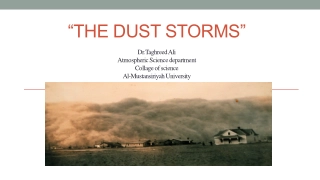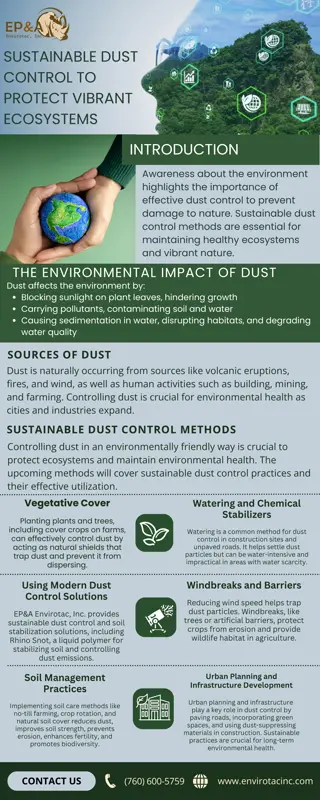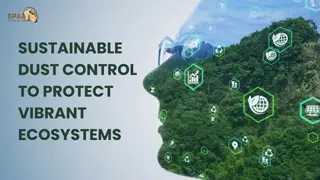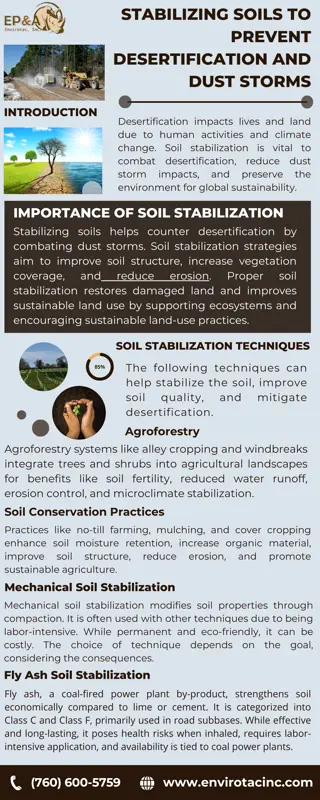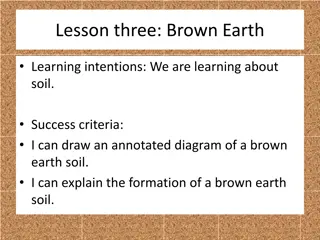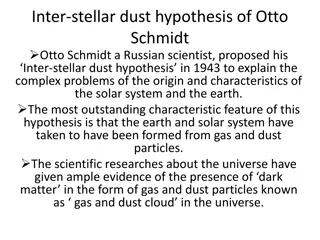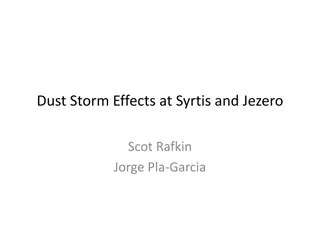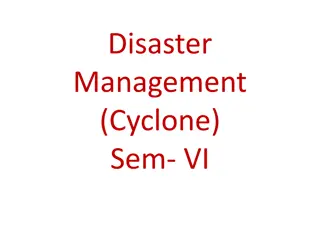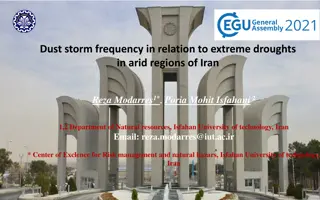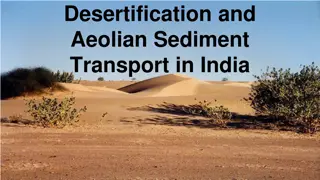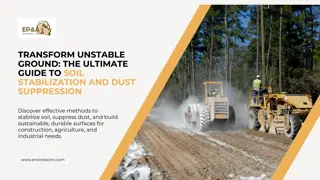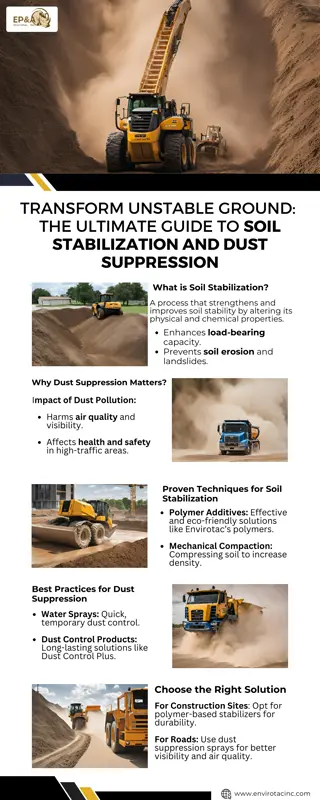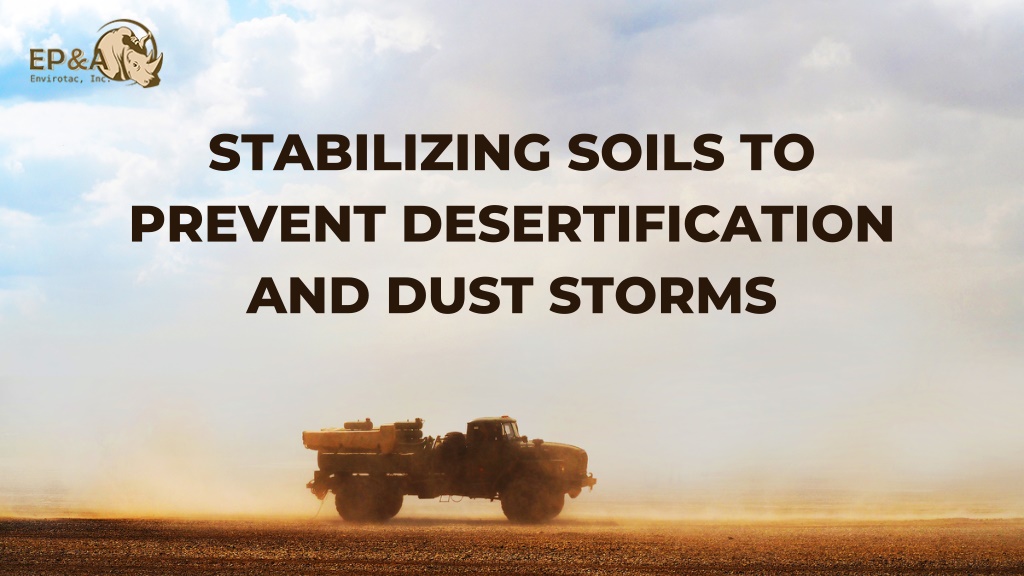
Stabilizing soils to prevent desertification and dust storms
Desertification impacts lives and land due to human activities and climate change. Soil stabilization is vital to combat desertification, reduce dust storm impacts, and preserve the environment for global sustainability.n
Download Presentation

Please find below an Image/Link to download the presentation.
The content on the website is provided AS IS for your information and personal use only. It may not be sold, licensed, or shared on other websites without obtaining consent from the author. Download presentation by click this link. If you encounter any issues during the download, it is possible that the publisher has removed the file from their server.
E N D
Presentation Transcript
STABILIZING SOILS TO PREVENT DESERTIFICATION AND DUST STORMS
INTRODUCTION Desertification affects millions of lives and vast land areas due to human activities and climate change. Soil stabilization techniques are crucial to combat desertification and reduce dust storm impacts. The article emphasizes the importance of soil stabilization in environmental preservation and global sustainability efforts.
IMPORTANCE OF SOIL STABILIZATION Stabilizing soils helps counter desertification by combating dust storms. Soil stabilization strategies aim to improve soil structure, increase vegetation coverage, and reduce erosion. Proper soil stabilization restores damaged land and improves sustainable land use by supporting ecosystems and encouraging sustainable land-use practices.
SOIL STABILIZATION TECHNIQUES The following techniques can help stabilize the soil, improve soil quality, and mitigate desertification. 85% Agroforestry Trees and shrubs can be incorporated in the agricultural landscape by integrating agroforestry systems for soil fertility, reduced water runoff, or enhanced biodiversity. Alley cropping and windbreaks are agroforestry systems that offer numerous benefits, such as erosion control and microclimate stabilization. Soil Conservation Practices They include no-till farming, mulching, and cover cropping; all these are activities that help in the retention of soil moisture and generally improve the amount of organic material that may be developed. They improve the general structure of the soil, hence decreasing erosion and thus encouraging sustainable agriculture.
WATER HARVESTING AND MANAGEMENT The techniques of rainwater harvesting and check dams store the rainwater and help get it recharged in groundwater, which, in turn, assists moisture content in the soil. Adequate water management thus promotes vegetation growth, enhances green cover, and reduces soil instability in arid and semi-arid regions.
POLYMER-BASED SOIL STABILIZATION Soil stabilization polymers improve soil quality and prevent erosion, combating desertification. Various polymer-based materials like bio polyesters, biobased copolymers, and microbial polymers have been studied for their effectiveness. They enhance soil structure, fertility, and combat erosion. Innovative solutions include polyelectrolytic gels and biomass-derived polymers. While polymers are easy to apply and compatible with all soils, they can be messy, short-lived, and require large quantities. Products like Soil Stabilization Plus by EP&A Envirotac, Inc. offer effective soil stabilization and dust control solutions.
CHLORIDES Chlorides like magnesium chloride and calcium chloride stabilize unpaved roads by capturing soil moisture, creating a hard, dust-free surface. They are cost-effective but need frequent re-application and raise environmental concerns due to high chloride levels introduced.
LIME AND CEMENT SOIL STABILIZATION Lime and cement soil stabilization is a method where the respective binder is mixed with material to gain strength. Lime is a natural binder, whereas cement is synthetic. It is a widely used method in paved road construction as a result of its high durability and strength. It works well with most soils but requires extensive soil testing and also proper management of the moisture content in it. Lime and cement stabilization is long-lasting and durable and dries wet soils. On the other hand, it is expensive and has high labor costs and health hazards due to inhaling fine powder, and its usage is mainly concerned with paved roads. Among various soil stabilization methods and materials, lime and cement stand out for their effectiveness despite their drawbacks.
FLY ASH SOIL STABILIZATION Fly ash is a by-product of coal-fired power plants, which is used as an agent of bonding and for increasing the strength of soil. Economically, it is viable compared to lime or cement; it performs well in soil that has a high moisture content. There are two classes: Class C - cementitious and pozzolanic and class F - only pozzolanic properties. Primarily, fly ash finds its use in the subbase of paved roads. While fly ash is a permanent and long-lasting solution, and it works well with most soils, it raises health concerns as a result of inhalation risks, is highly labor-intensive in application, and its availability depends on coal- fired power plants.
MECHANICAL SOIL STABILIZATION Mechanical soil stabilization is the modification of the physical properties of the soil through compaction to interlock particles. This method may be used as is or, often, contemporarily with another technique since it is extremely labor- intensive and time-consuming. This method is permanent and friendly to the environment, but it can be costly and seldom used on its own and is no longer a popular standalone method. The technique will depend on the goal you want to achieve, but one must keep in mind the consequences of the soil stabilization technique employed.
THANK YOU CONTACT US (760) 600-5759 www.envirotacinc.com

